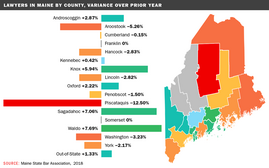ACA employer mandate moves full steam ahead
 Photo / Russ Dillingham
Emily Brostek, executive director of Consumers for Affordable Health Care, says fears that companies might shift employees to part-time status to avoid buying health insurance have not been borne out.
Photo / Russ Dillingham
Emily Brostek, executive director of Consumers for Affordable Health Care, says fears that companies might shift employees to part-time status to avoid buying health insurance have not been borne out.
The one-year grace period that delayed full implementation of the Affordable Care Act's employer shared responsibility rule, or the employer mandate, is coming to an end.
In 2015, firms with 100 or more full-time-equivalent employees had to insure at least 70% of their full-time workers.
For 2016, the mandate requires all businesses with 50 or more full-time equivalent employees to provide health insurance for at least 95% of their full-time employees, and dependents up to age 26, or pay a penalty. Employers must file information reports with the Internal Revenue Service with regard to coverage offered, or not offered, and must provide statements to their full-time employees about its offers of health coverage. Because this is a new program, short-term relief from penalties is available as employers figure out appropriate compliance procedures.
For most employers, this is more of a paperwork headache than anything else.
“Most large employers, and even most mid-size employers, already offer insurance that is in compliance with the ACA,” says Emily Brostek, executive director of the Augusta-based nonprofit Consumers for Affordable Health Care. “The vast majority of big firms offer good, comprehensive coverage. So there's not a ton of larger employers that have to make a change.”
Changes in 2016
Nationwide, 96% of firms with 50 or more full-time employees already offered coverage to full-time workers prior to the ACA, according to treasury.gov. Reflecting that number, most firms in Maine with 50 or more employees already offer health insurance. According to the Kaiser Family Foundation, in 2013, 97% of Maine's 7,912 private sector establishments — including incorporated for-profits and nonprofits, but not including unincorporated private sector firms or government establishments — offered health insurance.
However, some mid-sized employers find the issue is complicated by the threshold of 50-full-time-equivalent employees, as well as the ACA definition of full-time as 30 hours per week rather than the usual 40.
It's not a difficult tally for many employers, says Edward Feibel, a benefits specialist at the law firm Eaton Peabody, who, together with his partners, Leslie Hallock, David Wakelin and Anne O'Donovan, helps employers navigate the law.
“The employers I deal with have pretty stable workforces,” says Feibel. “They've already made their adjustments, in terms of how many hours of work they're hiring people for. They've adjusted budgets accordingly.”
But for some industries, notably those dependent on part-time or seasonal labor, it's a whole lot of arithmetic.
Healthcare.gov explains how to tally: The employer first counts its employees working an average of 30 or more hours per week as full-time employees. If the employer has employees working less than that, it determines the number of full-time equivalents by multiplying part-time hours by 52 weeks, then dividing by 12 months.
“It's very difficult to make a lot of the calculations,” says Augusta-based Maine Restaurant Association executive director Greg Dugal. “A lot of payroll companies have thankfully stepped up to figure out what needs to be accomplished. Reporting after the fact is still cumbersome, and it's sizeable expense to keep yourself in compliance.
Certain industries are more impacted by calculation woes than others. Hospitality and retail industries, with large numbers of seasonal and part-time workers, fall into that category. Even colleges and universities, with adjunct faculty, are affected.
“A lot of small colleges never really thought about adjuncts getting benefits,” says Hallock. “And now, all of a sudden, they have to.”
Tipping the balance
Employers with fewer than 50 employees are not subject to the mandate. But for workforces with approximately that number, a new hire could tip the balance.
“That 50-employee threshold is a real concern for folks,” says Curtis Picard, executive director of the Augusta-based Retail Association of Maine. “They feel it will be a hindrance when you bump up against the threshold.”
Some affected companies that don't offer health insurance, or offer inadequate insurance, are calculating whether it's more cost-effective to comply with the law or pay a tax penalty.
Insurance plans must meet a “minimum value” standard, which means a plan can't cost more than 9.5% of employee household income for employee-only coverage (employers can use employee income statements to stand in for household income). Employers must also contribute at least 60% of the cost for individual minimum essential coverage.
According to the National Center for Policy Analysis, health benefits are a significant expense for U.S. employers and a substantial portion of workers' total compensation. The Congressional Budget Office estimates that the required coverage for an individual will cost $5,800 a year or more in 2016 — the equivalent of an additional $3 an hour “minimum health wage.” Family coverage could cost more than twice that. The Kaiser Family Foundation's annual survey of employer health benefits found the average cost of an employee family plan was $16,351 in 2013.
This compares with the government's penalty: $2,000 for each full-time employee beyond the first 30. For employers that do provide coverage but don't provide coverage meeting minimum-value requirements, the penalty is the lesser of $3,000 per full-time employee receiving subsidies, or $2,000 per full-time employee (minus the first 30).
“I've had conversations with people who said they would just take the fine and send employees to the exchange, because it's less expensive to do that,” says Dugal.
Looking for loopholes
There are concerns, too, about what companies might do to avoid the higher costs.
“There was a worry that more employers might move some of their workforce to part-time so they wouldn't have to offer insurance,” says Brostek. “That has not been borne out. There's national data that there hasn't been an increase in the number of part-time employees since this passed, and I suspect that's true in Maine.”
According to the Center on Budget and Policy Priorities report from January, “Recent data provide scant evidence that health reform is causing a significant shift toward part-time work, contrary to the claims of critics,” adding that, nationwide, fewer than one-half of 1% of employees work 30 to 34 hours a week for employers that don't offer insurance.
But the U.S. Chamber of Commerce argues that the employer mandate could affect full-time hires, because it links the penalty to the number of full-time employees.
Dugal agrees with the latter assessment.
“It suppresses a lot of job growth, based on the fact that people are concerned they would pay these additional fees,” Dugal says.
That, on top of other workforce changes on the horizon, including movement toward a minimum and overtime pay hikes, is adding pressure for small business owners, he says.
“People are making decisions,” Dugal says. “The number of jobs available in the future are based on all of these calculations to keep employee numbers under the threshold. That will be with us a very long time, especially in our industry.”
The association would like to see the mandate kick in at 100 employees, rather than 50, Dugal says.
“In Maine, going from 50 to a hundred employees would eliminate a lot of employers from having to provide health insurance to their employees,” he says.
Companies with 50 to 99 employees might also face challenges with new pricing restrictions under the small-group community rating system, says O'Donovan at Eaton Peabody. Insurers can no longer use health status or gender to modify prices, although other factors such as tobacco use are still in place. That means some small groups might see their rates go up, while others go down. Up to now, this might have only affected employers of fewer than 50, because they constituted the definition of “small group.” But beginning in 2016, the definition is expanding to employers with 50-99 employees, so the new pricing restrictions could affect them as well.
While small employers of fewer than 50 FTEs don't have to provide insurance, they now have a new option should they choose to do so: the Small Business Health Options Program. In addition, employers with fewer than 25 FTEs, with average annual wages of less than $50,000, may be eligible for the Small Business Health Care Tax Credit, if they cover at least 50% of their full-time employee's premium costs. Small employers who provide coverage must report the cost of coverage.
According to the Kaiser Family Foundation, in 2013, 34% of the 29,171 firms in Maine with fewer than 50 FTEs offered health insurance.
Brostek says some small employers who are not required to offer health coverage can now afford it.
“Before the ACA,” she says, “they struggled with costs and struggled to be able to provide comprehensive coverage. They often offered plans with high deductibles because it was all they could afford. Many have decided to send their employees to the individual marketplace instead, to take advantage of the tax credits, and sometimes they've even given them a pay increase or stipend to compensate them for their premium. That's a change we've seen in Maine with small employers.”














Comments